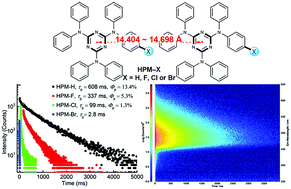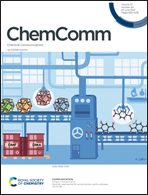Ultralong room-temperature phosphorescence remarkably weakened by halogenation-induced molecular packing in hexaphenylmelamine derivatives†
Abstract
A series of pure organic halogenated hexaphenylmelamine (HPM) derivatives featuring remarkably weakened ultralong room-temperature phosphorescence (RTP) were meticulously investigated. As the p-substituted atoms of these HPM derivatives sequentially changed from H to F, Cl and Br, both the RTP lifetimes and efficiencies dramatically decreased from 608 ms with 13.4% (HPM-H) to 337 ms with 5.3% (HPM-F), 99 ms with 1.3% (HPM-Cl), and 2.8 ms with undetectable efficiency (HPM-Br), respectively. Most notably, the severely weakened efficiencies are fundamentally different from the trends of the effect of halogenation on phosphorescence properties previously reported. Coupled with experimental results and theoretical simulations, the subtle change of molecular packing induced by halogenation should be responsible for the distinctive RTP properties. This finding not only provides a unique halogen-involved RTP phenomenon, but also offers a very special perspective to understand the effect of halogenation on phosphorescence.



 Please wait while we load your content...
Please wait while we load your content...